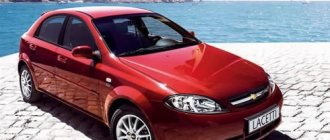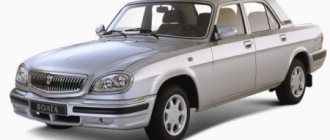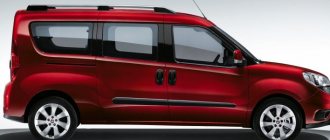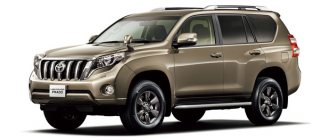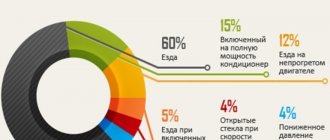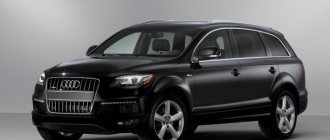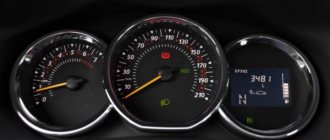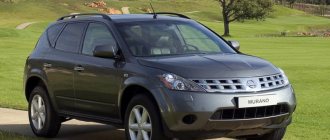The Mazda CX-7 is an all-wheel drive mid-size car that went into production in 2006. It debuted at the Los Angeles Auto Center, and a few months later was already available for sale. The production model is based on the 2005 MX-Crossport concept car. The Mazda CX-7 was manufactured at the Japanese plant in Hiroshima. The advantages of the model compared to its opponents are commendable steering feedback, luxury equipment and powerful engines. Among the minuses, it is possible to highlight the mediocre cross-country ability, sacrificed for taxiing. Competitors of the Mazda CX-7 should be considered the Chevrolet Captiva, Toyota RAV-4 and Honda CR-V. In 2010, the model received a restyling, and two years later, production of the CX-7 was completed due to an outdated layout. This SUV was replaced by the more current CX-5 model.
How to reduce fuel consumption - 10 TIPS
We are talking about principles that excessively increase fuel consumption during operation.
- A dirty air filter impairs the performance of the air supplied to the engine. Naturally, this affects the parameters of the fuel mixture. Such a violation can significantly increase consumption and reduce power. Don't delay replacing the filter.
- A dirty oil filter similarly complicates the operation of the internal combustion engine.
- Insufficient tire pressure will require more fuel. The rolling gets worse. Check your tire pressure regularly.
- Warming up the engine before driving provides minor fuel savings.
- Low quality gasoline, we are talking not only about consumption, but also about additional harmful effects on individual engine components.
- Impaired wheel alignment and camber acts similarly to tires with insufficient pressure, and rolling resistance increases.
- Electric consumers influence fuel consumption. The air conditioner produces the highest consumption.
- Car load. Empty the trunk of “useful” and “necessary” things; at short intervals the difference will not be noticeable, but over the course of a year you will save a dozen or so liters.
- Keep the revs low according to the transmission capabilities
- Air resistance at high speeds; the higher the speed, the more the oncoming air masses hinder the movement of the car.
Mazda CX-7 engine 2.3 l
Initially, all configurations of the Mazda CX-7 were equipped with a 2.3-liter turbocharged engine developing 238 hp. Such high power was intended for all-wheel drive, but in urban conditions the engine was too powerful, and also consumed an prohibitive amount of fuel for a city crossover.
Fuel consumption rate for Mazda CX-7 2.3 gasoline – reviews
- Gennady, Perm. I bought the car second-hand, but in excellent quality - the previous owner was a friend of mine, I know that he treated the car very well. Therefore, despite the fact that the car is already 7 years old, of which I have had it for 2 years, there are no problems with it. The only problem is high gas consumption; in the city or off-road I get at least 15 liters. I'm thinking of selling it and getting a diesel.
- Nikolay, Saratov. Mazda CX-7, 2.3AT, 2010. I don't like the car at all. For off-road use it is of no use - a little more dirt and it will get stuck tightly, but it is heavy and difficult to pull out. A purely urban crossover - but here the gasoline consumption makes itself felt, which on the highway is 10-11 liters, and in the city generally no less than 14 liters.
- Stanislav, Stavropol. A typical city crossover, at most - a trip to the dacha. You can’t go fishing on it, it’s better not to try - I once tried it on my own. If there are no traffic jams, then the consumption is even less, up to 13-14 liters, but I went to Moscow on business - I got all 16 there.
- Evgeniy, Moscow. The second car was bought specifically for outings. I read reviews that say it copes poorly with off-road conditions - complete nonsense. Never got stuck, pulled me out of any mud. This is, of course, not a Defender or a Gilik, it’s better not to get into a serious swamp with it, so it is positioned as a crossover, and not a pure SUV. Off-road consumption is high - up to 20 liters, in the city in traffic jams I get up to 17 (if with an air conditioner).
- Georgy, Kaliningrad. Mazda CX-7, 2007, 2.3 liter engine. The car is excellent - the assembly is of high quality, everything is up to par. In five years, nothing has NEVER broken. In terms of consumption, it’s really big, in the city it’s at least 15-16 liters, and the engine has almost 250 horsepower, so it’s quite justified.
- Sergey, Rivne. A very pleasant and easy-to-drive car - it holds the road well and walks confidently through snow and mud. Version with all-wheel drive, automatic transmission and 2.3 liter engine. In the city the consumption is 15 liters, on the highway – up to 12. If you press the pedal, then of course it will come out more.
- Igor, Tomsk. Mazda CX-7, 2.3AT 4WD, 2008. I always wanted to buy myself some kind of all-wheel drive SUV - but at the same time, in addition to off-road qualities, I wanted dynamics and speed. The choice fell on a crossover from Mazda - after all, there is all-wheel drive, and the engine produces 250 hp. – quite acceptable. I bought it with a mileage of almost 60 thousand km, but the condition is perfect, like new. Everything is good, everything is convenient - but in the city sometimes in traffic jams the consumption can be up to 25 liters. UP TO 25 liters. On average (highway + city) – about 14-15 liters.
- Evgeniy, Surgut. Not everyone knows what winters are like in the North, but I will say this: we have nothing to do without an SUV with all-wheel drive. For the same reason, I chose exclusively 4WD. Based on an acquaintance, they suggested a Mazda CX-7, with a 2.3 engine and an automatic transmission. They immediately warned about fuel - in the winter in the city it comes out to 22-23 liters (well, yes, it’s understandable - you can’t accelerate above third), in the summer on the highway - 13-14 (if you drive up to 140 km/h). That's how it goes. On the other hand, those who have engines with a power of more than 200-250 hp have the same consumption.
Mazda CX-7 engines. Official fuel consumption per 100 km.
Generation 1 (2006-2009)
Engines (gasoline):
- 2.3, 238 hp. forces, automatic transmission, all-wheel drive, 8.3 acceleration to 100 km/h (in seconds), 15.3/9.3 consumption
Restyle 1st generation (2010-2012)
Engines (gasoline):
- 2.5, 163 hp. forces, automatic transmission, front-wheel drive, 10.3 acceleration to 100 km/h (in seconds), 12.7/7.5 consumption
- 2.3, 238 hp. power, automatic transmission, all-wheel drive, 8.3 seconds to 100 km/h, 15.3/9.3 consumption
Official data (l/100 km)
The Mazda CX-7 was equipped with one type of engine. It was a four-cylinder power plant with a volume of 2.3 liters. It can produce 238 or 260 horsepower. In the first case, the engine was controlled by a six-speed robotic gearbox, and in the second - also by a six-speed, but manual. For both versions it was possible to choose either all-wheel drive or front-wheel drive. Thanks to such indicators, the car could reach speeds of up to 181 or 210 kilometers per hour, and accelerate to hundreds in 8.5 and 8 seconds, respectively. Fuel consumption per 100 km varied from 11.2 to 11.7 liters.
After a slight restyling, which took place in 2008, the model also acquired new power units. The 2.3-liter engine remained unchanged, except that only four-wheel drive was installed on it. The new gasoline engine was a 2.5 liter engine developing 163 horsepower. He was paired with either a robot or a mechanic, both at five levels.
This configuration had only front-wheel drive. Gasoline consumption for this version was 9.5 liters. Also new is a 2.2-liter diesel unit. Its peak power is indicated at 173 horsepower. It was equipped only with a manual transmission and only with all-wheel drive. This installation consumed 7.6 liters of fuel.
Mazda CX-7 real fuel consumption per 100 km: reviews
With 2.3 engine
- Arkady, Tambov. The car was manufactured in 2008, purchased in a fresh condition. Wonderful 2.3-liter. I actually bought the engine because of it. Acceleration to 100 km/h in eight seconds. This is not an all-wheel drive car, its cross-country ability is sacrificed for taxiing, and these days this can be considered an advantage. The Mazda CX-7 is a shining example of an SUV of its time, it’s a pity that it was discontinued. I would buy the next generation, but alas. The car consumes 17 liters per hundred kilometers.
- Roman, Yakutsk. My Mazda CX-7 is equipped with a 2.3-liter turbo engine that produces 240 horsepower. The excellent performance of the internal combustion engine allows it to push on all roads, but I really love doing this, for example, when starting from a standstill, at traffic lights. Consumption 16-17 liters
- Lev, Svetlogorsk. Mazda manufactured in 2009, pre-restyle equipment. I've been riding until now, covering 120 thousand kilometers. There are practically no malfunctions; in extreme cases, it can only be repaired at a car dealer. The approximate fuel consumption with a 2.3 power unit is 15 liters.
- Ilya, Ussuriysk. A car for any purpose - comfortable and dynamic, taxiing is one of the best in the car class. It's somewhat bouncy, but that can be forgiven in favor of what the Mazda can do on the road. Large wheels, a sporty contour, a spacious interior and a spacious trunk. In the engine compartment, the engine is 2.3, produces 240 horsepower and consumes 15-16 liters.
- Alexander, Chrysostom. A very dynamic car, perhaps even faster than the most powerful Volkswagen Tiguan, a friend had the opportunity to drive one. The car pleased me with its high-quality interior, good cross-country ability in city mode and distinct responsiveness of the steering wheel. Consumption in urban environments up to 17 liters
- Roman, Almetyevsk. The Mazda CX-7 gave me mixed feelings. The car is very powerful, but consumes a lot. In the city I clean at 17 liters, which is no longer relevant today. I had to solve the problem by installing HBO.
- Vladislav, Omsk. The car is beautiful, looks sporty and drives quickly, has a roomy interior and a roomy trunk, into which you can load anything, and in an extreme case, fold the back row and load it to the maximum. The 2.3 power unit produces 240 horsepower and consumes 17-18 liters.
- David, Murom. The Mazda CX-7 is worth the money spent; in terms of the auto class, it drives more profitably than numerous opponents. Mediocre visibility and pragmatism, low off-road performance - all this, of course, was sacrificed for the sake of sportiness. And I’m very happy about this, I knew everything I was getting. High-quality interior materials, luxury equipment, pragmatic leather seats, many electrical adjustments and a powerful stereo system. Productive 2.3-liter. the power unit consumes 16-17 liters.
- Svetlana, Adler. I am quite satisfied with the machine, a machine for all occasions. Used in family and at work. I drive Mazda all the time, studying its positive aspects and disadvantages, but there are clearly many more of the former. It’s just that the consumption has let me down - it’s impossible to get less than 15 liters.
- Vitaly, Engels. A typical city SUV, it is also exemplary for straight and even winding roads. It steers and brakes well, the moderately informative steering wheel and rough chassis do their job. The car goes faster than even some passenger cars, which I deserve. 240 horsepower is enough to accelerate to 100 km/h in 8 seconds. Consumption 16 l.
- Ilya, Tver region. Mazda CX-7 is an excellent and high-quality car, a typical example of the Japanese automobile industry. Powerful and solid, can be repaired by a car dealer. Odometer reading is 75 thousand, consumption is 14-16 liters.
- Peter, MSK. The optimal car for city roads and highways, suitable for household needs, although the chassis still makes itself felt - very elastic, the car just begs to be driven on smooth asphalt. A powerful engine, a hurricane degree of acceleration and glorious feedback on the steering wheel. Consumption 14 l.
- Elizaveta, Rybinsk. In the end, I am satisfied with the car, a worthy option for young people or those who are young at heart. The car consumes 15 liters in urban conditions, on the highway I get 13 l/100.
- Evgeny, Tambov. I received a Mazda CX-7 from a good friend, with a number on the odometer of 70 thousand kilometers. During this time, the headlights and radiator grille were replaced, as well as the bumpers and hood - all these parts were victims of a minor head-on accident. Otherwise, everything is ok, the car pleases with its solidity and responsive power unit. Consumes 15 liters/100 km.
- Ilya, Kaluga. In the end, I'm satisfied with the car, it's a take-off machine. With its powerful power unit, it is possible to drive around either in urban conditions or at long distances outside the city. The maximum power of 240 horsepower is sufficient, the car is quite light and small-sized. It handles amazingly, without any annoying rolls when cornering. Typical consumption per hundred kilometers. at around 15 liters. A lot, but it's worth it. I fill it with AI-95.
Passport details
The reason for the manufacturer’s refusal to use a 2.3-liter turbocharged power unit is the power – 238 hp. With. These parameters are quite consistent with an all-wheel drive crossover when driving off-road. However, due to the fact that most buyers used the car only in urban environments, the engine’s capabilities were not even half used. Moreover, gasoline consumption still remained too high for many consumers.
Table 1. Technical characteristics and consumption of the model’s engines according to the vehicle documentation.
| Parameter | Meaning | ||
| Engine volume, l | 2,3 | 2,5 | 2,2 |
| Type of fuel | petrol | diesel fuel | |
| Power, l. With. | 238 | 163 | 173 |
| Fuel consumption (city/highway/mixed) | 15,3 / 9,3 / 11,5 | 12,7 / 7,5 / 9,4 | 9,1 / 6,6 / 7,5 |
| Maximum speed | 211 | 200 | 173 |
New engine with 163 hp. With. should have been the best option for an urban SUV. In addition, a four-cylinder power unit was installed on front-wheel drive models, which made fuel consumption even lower. And the diesel version of the engine made it possible to reduce consumption by more than 1.5 times - although such modifications were not sold in the Russian Federation.
Rice. 2. Petrol 2.3-liter crossover engine.
Mazda CX 7 fuel consumption
Added to Fuel consumption //
Real reviews from owners about fuel consumption on the Mazda CX 7:
2.3 l., engine, manual transmission:
- I'm simply surprised by the car's fuel consumption with a volume of 2.3 liters, in the bad sense of the word. On the highway it turns out to be up to 22 liters per 100 km, and the city takes 24 liters of fuel from the tank.
- I think that soon I will have to settle at a gas station with such an appetite for cars and tank volume. These 68 liters fly away quite quickly when consuming 22 liters of gasoline. So this is if you don’t drive. I like to start sharply and not limit myself in speed mode, so fuel consumption of 30 liters per 100 km is already the norm for me. By the way, I always check my gasoline consumption personally “from full to full.” As a result, I realized that the fuel consumption for the Mazda CX 7, indicated by the on-board computer, is almost always too high by one.
- In the city, gasoline consumption fluctuates around 22 liters per 100 km. This figure is clearly not the norm for a 2.3 liter engine. When I bought my car, I also reviewed all the reviews on the Internet, and now I myself have joined the ranks in this matter.
Mazda CX 7 in 2.3 liter version, mileage over 110 thousand km
- I drive calmly, both around the city and outside of it. Fuel consumption is 18 liters per 100 km traveled. What kind of car is this? Maybe I bought a SPERM WHALE? Damn, I read the reviews, everyone there also shouted that the car had too much appetite, but I had to buy it myself. I thought maybe it would blow me away, saying I was driving calmly and everything would be fine, but as it turned out, it wasn’t.
- The car clearly loves aggressive driving, but the fuel consumption of 20 liters is very expensive. If you prefer moderate driving, prepare for consumption of 14 liters per 100 km on the highway.
- I read reviews from the owners and found myself envious. Yes, I envy those who are able to curb the fuel consumption of the Mazda CX 7. My figure always exceeds 18 liters per car of the distance traveled, this is with an engine volume of 2.3 liters.
- Of course, the real fuel consumption of the Mazda CX 7, and not what is stated in the passport, is simply off the charts, but if you look closely... The number of horses is decent, whatever one may say. I think this is why the numbers are so high. Although I like my Japanese girl, whatever one may say. How much she made me happy on the road, when traveling to the country, on long journeys to other cities, long trips on vacation with her beloved family, at the seaside. I love her no matter what)
Mazda CX 7 with a volume of 2.3 liters. petrol, automatic transmission:
- I live in the suburbs of Kyiv (Ukraine). Every day you have to get through traffic jams to work. The funny thing is that fuel consumption is up to 16 liters per 100 km in the combined cycle. How shoud I understand this?
- It consumes an exorbitant amount of fuel. What can I say? The road to work is boring and long. I only amuse myself by trying to keep the gasoline consumption of the Mazda CX 7 below 16 liters, which, let me tell you, is very difficult. People's reviews don't lie on the Internet. My record is 11 liters per hundred, but I don’t even know how it happened.
Mazda CX 7 with a car volume of 2.3 liters
- The car has only an appearance. Her appetite is 14.5 liters per hundred square meters. I commute to work every day. I'm afraid that soon, due to such gasoline consumption, we will have to travel by minibuses.
- I was ready for such high gasoline consumption, but this fact is not at all pleasing - 19 liters per 100 km in the city. But do I like the car? How to sell it? It will have to, its fuel consumption on a 2.3 liter engine is too high.
Version of the car with a 2.3 liter engine
- Due to the saturation of the engine with “horses”, gasoline consumption is up to 26 liters per 100 km.
- The manufacturer has specified clear standards, but I just can’t follow them. And I don’t know people who are capable. I talked to many owners, everyone complained about fuel consumption. I should have read the reviews before buying my Mazda, but unfortunately I didn’t do that. But at least now, I have a chance to warn other people about the appetite of this car.
- I live in Yekaterinburg. In the city I usually get 22 liters per hundred. This is true with a calm driving style. What can we say about the gasoline consumption of those who like to make an emergency start at a traffic light?
We weigh the chances of success of the Mazda CX-7 2.5 crossover
For Russia, the CX-7 2.5 is one package for 1,130,000 rubles. Twenty thousand on top are a rain sensor, a rear view camera and a radio with another 15 thousand - “metallic”. Leather and xenon are not available. Warranty: three years or 100,000 km.
All around, the Mazda CX-7 crossover would be good, if not for its appetite. Even when derated to 238 hp, the 2.3 turbo engine from the MPS three-ruble note could easily consume more than 20 liters of gasoline per 100 km. The all-wheel drive has a reputation for being a glutton that is harmful to sales. In 2010, the Mazda CX-7 fell out of the top ten most popular SUVs: 4,059 cars were sold versus, for example, 16,158 Nissans sold. And here in front of me is a potential revenge-seeker - a CX-7 with a naturally aspirated 2.5 engine, a five-speed automatic transmission and front-wheel drive. How to eat under the scorching sun of Armenia.
The in-line “four” with a displacement of 2488 cm³ has been installed on the Mazda6 sedan since 2007. Here it develops 163 forces and 205 N•m. With a curb weight of 1586 kg, the power output of the single-drive version is 103 “horses” per ton, while the supercharged version has 139. But, according to Mazda, the potential buyer of the four-cylinder modification is not interested in the dynamic characteristics: they supposedly have other priorities.
The single-wheel drive Mazda CX-7 is identified by its single exhaust pipe.
On the streets of Yerevan, Mazda behaves phlegmatically. The engine is more or less successful from 2500 rpm, but it feels like it wilts before 6000 rpm, which according to the passport is the peak power. But even “in the moment” you can move in dense traffic without resorting to kickdown. However, the city is only a prelude: we are on our way to the 13th century Noravank monastery, which is 122 km from the capital.
The two-tone front panel is presentable, but there is no soft plastic here. It is only present on the top of the door panels. The light music of the dashboard is beautiful and does not interfere with the perception of information. It is a little more difficult to read data from two different-sized displays under the windshield.
There are mountains all around, reminiscent of the Carpathians or the Alps, almost New Zealand green hills adjacent to lakes and rocks red with copper. The roads are for every taste: long highway straights give way to serpentines with countless ups and downs. Mazda encourages thoughts of meeting a serene old age in this piece of paradise.
There are no issues with the brakes in the city or on the highway. The pedal has a short stroke, and with force you can finely control the level of deceleration. But on mountain paths the mechanisms overheat and fail.
Her temperament is definitely only enough to overtake a slow-moving vehicle traveling at speeds of up to 60 km/h. If you come across a faster ride, the process is delayed. First, you yourself estimate the chances of a successful maneuver, then the “automatic machine” figures out which gear to use. The box reacts differently to equal force and sharpness of accelerator movements: either with a two-second delay it moves down two steps, or it decides to torment the engine and driver within the current gear.
- Electric seats are an unaffordable luxury. As well as, for example, the keyless entry system. The simple-looking seats are tightly padded and perfectly hold the body in turns, and on a long journey they do not strain either the back or the hips. Adjustments allow you to sit low like a car.
- There is not a ton of space in the back; there is enough headroom and room in the knees so as not to feel discomfort. But the third one on the sofa is superfluous.
Theoretically, there is a manual mode, but it is not possible to use it intelligently, for example, in the mountains due to the non-optimal selection of gear ratios. The step between the first and second is too large: one has already been used, the other is not yet suitable. On the climbs there is not enough torque that was enough in the city. You have to overtake while moving - it’s dangerous! As soon as the speedometer needle turns o, kickdown assistance does not save the engine from shortness of breath. And after 120 km/h, you can forget about distinct acceleration and be content with monotonous movement in space. The buyer of such a Mazda CX-7 is in no hurry.
The advantage of the cargo compartment can be considered a wide opening and a flat floor, which is formed when the rear seats are folded. The downsides are the high loading height and protruding wheel arches. In addition to storage and tools, a couple of trays for small items are hidden in the underground.
But you can take your time to enjoy the balanced chassis and steering. Even though the drive to the rear axle has been removed, the suspension is still perfectly tuned. According to the creators, the chassis settings for Russia are something between the characteristics of cars for Europe and North America. “Our” Mazdas are less sporty than European ones, but more exciting than those intended for the USA and Canada.
Spurring 163 “horses” at speeds over a hundred, you get no satisfaction from either the acceleration or the soundtrack. The rated top speed is 173 km/h, but we didn't find a straight line long enough to test it. Aerodynamic noise is clearly evident closer to 100 km/h in the area of the A-pillars and side mirrors.
Noticeable rolls and slight lateral rocking do not spoil the impression - on the dizzying paths of the Lori region, the Mazda is no less captivating than a skilled dance partner. The “Japanese” is tenacious in gentle turns and responsive when steering in alternating directions on “snakes”. There is enough information: you know when the front wheels lose traction at the limit or when the asphalt road is strewn with small stones. Although the tires are quite civil size 215/70 R17. Their withdrawals create a small zone of low sensitivity “at zero”, but beyond this there are responses to movements by the steering wheel.
When it comes to fast “esques”, the steering pleases with both acceptable effort and information content. But as soon as the road straightens out, the connection with the car weakens. The chassis is set up safely. Roll increases smoothly with increasing steering angle. If you go too fast in a corner, the Mazda will helplessly slide its front axle towards the outer curb. Provocative release of gas in a fast arc does not cause skidding.
Surprisingly, this suspension setup does not imply rigidity - the Mazda CX-7 is comfortable. Regardless of the size of the holes and potholes, only smooth shocks come to the seats. And the main discomfort is that almost any unevenness is voiced by the chassis with sighs and loud blows. You can hear all this perfectly, since other sources of noise in the cabin are present unobtrusively: the 2.5 engine makes a noticeable noise only at 5000 rpm, and the rustling of the tires is heard muffled.
When it’s dry all around, the front-wheel drive doesn’t bother you either on the field or on gravel and large stones - after all, the ground clearance is 208 mm. But if it rained here for a week.
Judging by the statistics, the Mazda team hit the bull's eye with the front-wheel drive. In the couple of months that the simplified modification has been taking root on the market, its share of orders from the total number of purchased CX-7 crossovers has almost reached 40%. The line stretched until late autumn. This happens if you sell a balanced SUV with a bright design, a spacious interior and decent equipment for 1,130,000 rubles. The main problem has been solved. In a real mixed cycle (city, highway, serpentines), the crossover consumes less than 11 liters per hundred. And on a suburban highway at a constant speed, consumption does not exceed nine liters. The dynamics are now, as it were, on the list of additional equipment: by paying an additional 155 thousand, you can still become the owner of the version. Depends on priorities.
Passport details
| Mazda CX-7 | 2.5 AT |
| Body | |
| Body type | station wagon |
| Number of doors/seats | 5/5 |
| Length, mm | 4680 |
| Width, mm | 1870 |
| Height, mm | 1645 |
| Wheelbase, mm | 2750 |
| Front/rear track, mm | 1617/1612 |
| Curb weight, kg | 1631 |
| Total weight, kg | 2099 |
| Trunk volume, l | 455/1640 |
| Engine | |
| Type | petrol |
| Location | front, transverse |
| Number and arrangement of cylinders | 4, in a row |
| Number of valves | 16 |
| Working volume, cm³ | 2488 |
| Max. power, hp/rpm | 163/6000 |
| Max. torque, N•m/rpm | 205/2000 |
| Transmission | |
| Transmission | automatic five-speed |
| Drive unit | front |
| Chassis | |
| Front suspension | independent, spring, McPherson |
| Rear suspension | independent, spring, multi-link |
| Front brakes | ventilated disc |
| Rear brakes | ventilated disc |
| Tires | 215/70 R17 |
| Ground clearance, mm | 208 |
| Performance characteristics | |
| Maximum speed, km/h | 173 |
| Acceleration time from 0 to 100 km/h, s | 10,3 |
| Fuel consumption, l/100 km | |
| — urban cycle | 12,7 |
| - suburban cycle | 7,5 |
| - mixed cycle | 9,4 |
| Toxicity standard | Euro 4 |
| Fuel tank capacity, l | 62 |
| Fuel | AI-95 |
Technique
In 2007, the four-cylinder L5-VE engine of the MZR family first appeared in the second generation Mazda 6. But it is based on the L3-VE “four” with a working volume of 2.3 liters, the same age as the zoom. Version 2.5 has a larger cylinder diameter and piston stroke, a modernized intake system and a more advanced gas distribution mechanism. Recoil increased by only 4 hp. and 19 N•m, but average fuel consumption decreased by 6.9%. On the Mazda CX-7, the 2.5 engine develops 163 “horses” and 205 N•m, consuming gasoline. The fuel tank capacity of a front-wheel drive car is smaller than that of an all-wheel drive car: 62 liters versus 69.
The five-speed automatic transmission with manual gear selection is also old. The JF506E gearbox produced by Nissan’s subsidiary Jatco was equipped with both the second-generation Mazda MPV compact van and the “third” Ford Mondeo together with its English relative Jaguar. This “hydromechanics” was even used on some models of the Volkswagen concern. It does not have sport or winter modes, and shifts take a long time, but are extremely smooth.
Behind the scenes
Armenia is a country of stones. It is cheaper to build houses here from tuff than from wood. We saw this with our own eyes. A local historian, an interesting storyteller with emotional gestures, told us about the majestic stone-mining past of Armenia. In a matter of minutes, he captured the audience, and we literally listened to the lecture with our mouths open. Various rock samples passed through our hands: impressive obsidian, which the Armenians called the claws of Satan, colorful malachite, quartz, and divinely beautiful turquoise and copper ore. Before, I had only seen this in pictures.
